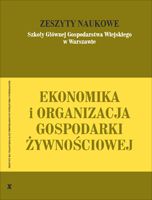Main Article Content
Article Details
A. Krueger, M. Schiff, A. Valdes, 1988: Agricultural incentives in developing countries: measuring the effect of sectoral and economywide policies. The World Bank Economic Review., vol. 2, nr 3, str. 255-271. (Crossref)
B. Hill, 1992: Total income of agricultural households: 1992 Report., Eurostat, Luxembourg.
B.L. Gardner, 1992: Changing economic perspectives on the farm problem, Journal of Economic Literature, vol. XXX, str. 62-101.
D. Newbery, 1987: The theory of agricultural taxation for developing countries. [W]: D. Newbery, N. Stern (ed.): The theory of taxation in developing countries.
D.W. Pearse, 1993: MacMillan Dictionary of Modern Economics., Wyd. MacMillan. (Crossref)
European Commission (1996): European Economy, Annual Economic Report for 1995.
European Commission, 1993: EC agricultural policyforthe21st century. Explaining agricultural policy, Brussels.
European Commission, 1996: The Agricultural Situation in the European Union. 1995 Report, Wyd. ESSC Brussels.
Eurostat (1996): Revenue Agricole 1995.
K. Anderson, Y. Rayami, 1986: The political economy of agricultural protection: East Asia in international perspective., Wyd. Allen i Unwin, Londyn.
M. Honma, Y. Hayami, 1986: The determinants of agricultural protection levels: an econometric analysis. [W]: K. Anderson, Y. Hayami: The political economy of agricultural protection: East Asia in intonational perspective., wyd. Allen and Unwin, Londyn str. 39-49.
M. Tracy, 1989: Government and agriculture in Western Europe 1980,-1988, 3rd ed. Harvester Wheatsleaf.
P.H. Lindert, 1991: Historical patterns of agricultural policy. [W] C.P. Timmer (wyd.), 1991: Agriculture and the State.
W. Michna: Bezpieczeństwo żywnościowe i polityka rolna Polski na przełomie XX i XXI wieku., [W]: Polityka ekonomiczna i społeczna, zeszyt 22, Wyd. Fundacja im. Friedricha Eberta, Warszawa 1992.
Downloads
- Aldona Zawojska, Tomasz Siudek, Finansowe i pozafinansowe formy wspierania ochrony środowiska , Zeszyty Naukowe SGGW - Ekonomika i Organizacja Gospodarki Żywnościowej: Nr 38 (2000)
- Tomasz Siudek, Katarzyna Drabarczyk, Aldona Zawojska, Rozwój społeczny powiatów województwa mazowieckiego – kwantyfikacja i ocena , Zeszyty Naukowe SGGW - Ekonomika i Organizacja Gospodarki Żywnościowej: Nr 123 (2018)
- Aldona Zawojska, Beata Horbowiec, Ryzyko cenowe na rynku produktów rolno-żywnościowych: źródła, skutki i sposoby zarządzania , Zeszyty Naukowe SGGW - Ekonomika i Organizacja Gospodarki Żywnościowej: Nr 115 (2016)
- Aldona Zawojska, Wpływ wspólnej waluty europejskiej na rozwój sektora rolno-spożywczego , Zeszyty Naukowe SGGW - Ekonomika i Organizacja Gospodarki Żywnościowej: Nr 40 (2000)
- Aldona Zawojska, Liberalizm, neoliberalizm, wolność ekonomiczna i polityczna a rozwój gospodarczy kraju , Zeszyty Naukowe SGGW - Ekonomika i Organizacja Gospodarki Żywnościowej: Nr 58 (2006)
- Aldona Zawojska, Spekulacja jako forma aktywności ekonomicznej – aspekty moralne i etyczne , Zeszyty Naukowe SGGW - Ekonomika i Organizacja Gospodarki Żywnościowej: Nr 83 (2010)
- Aldona Zawojska, Uwarunkowania i kanały finansowania rolnictwa w Polsce , Zeszyty Naukowe SGGW - Ekonomika i Organizacja Gospodarki Żywnościowej: Nr 65 (2008)
- Aldona Zawojska, Alina Daniłowska, Sprawozdanie z udziału w V Kongresie Stowarzyszenia Ekonomistów Rolnictwa i Agrobiznesu "Agrobiznes w krajach Europy Środkowej w aspekcie integracji z Unią Europejską" , Zeszyty Naukowe SGGW - Ekonomika i Organizacja Gospodarki Żywnościowej: Nr 36 (1999)
- Aldona Zawojska, Zrozumienie korupcji, jej przyczyn i skutków w ujęciu ekonomicznym , Zeszyty Naukowe SGGW - Ekonomika i Organizacja Gospodarki Żywnościowej: Nr 51 (2003)
- Aldona Zawojska, Strefa euro a nowe kraje członkowskie Unii Europejskiej - dywergencja czy konwergencja gospodarcza? , Zeszyty Naukowe SGGW - Ekonomika i Organizacja Gospodarki Żywnościowej: Nr 53 (2004)





